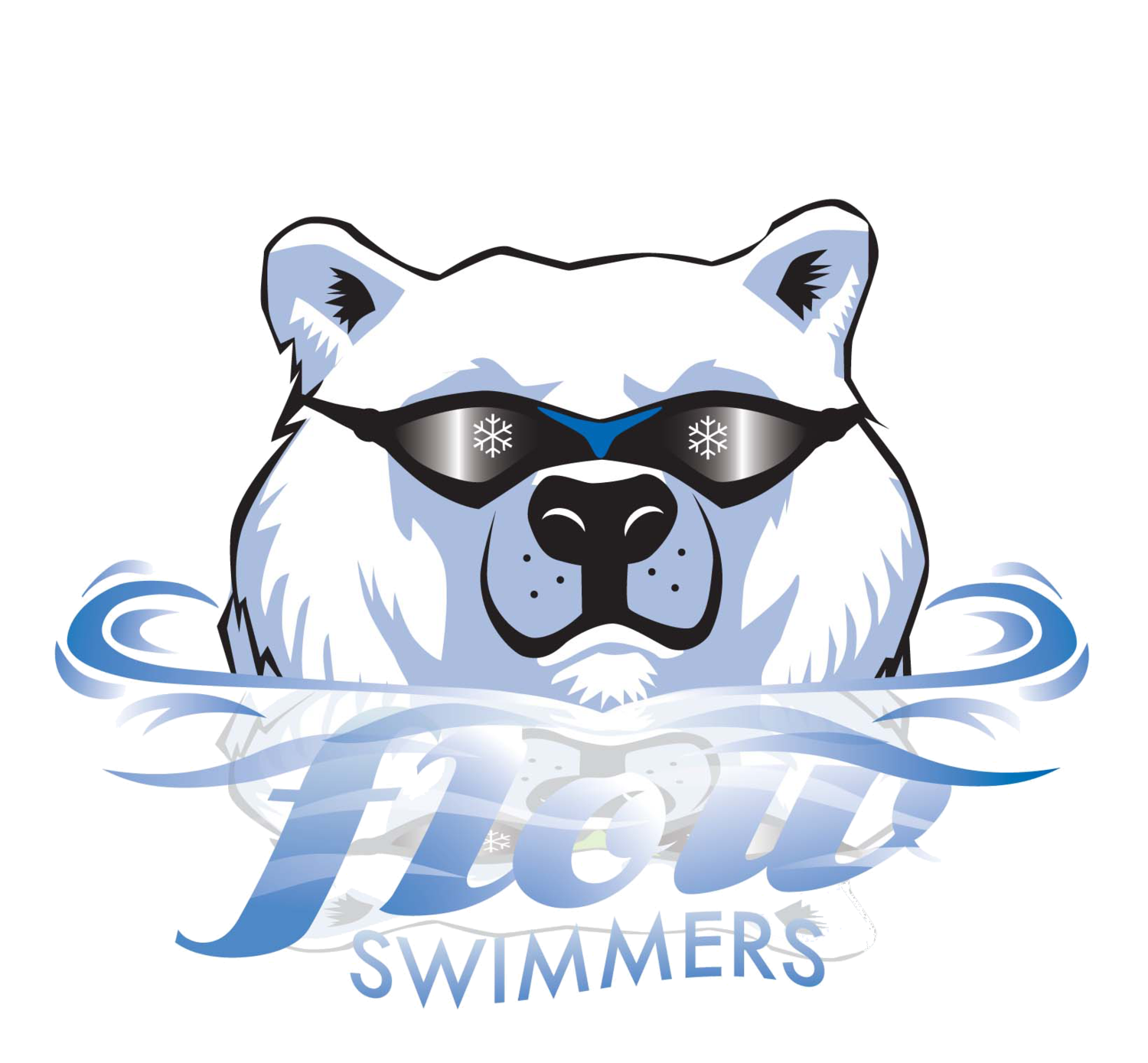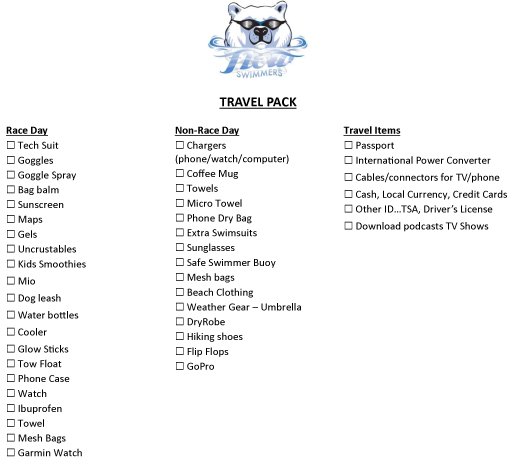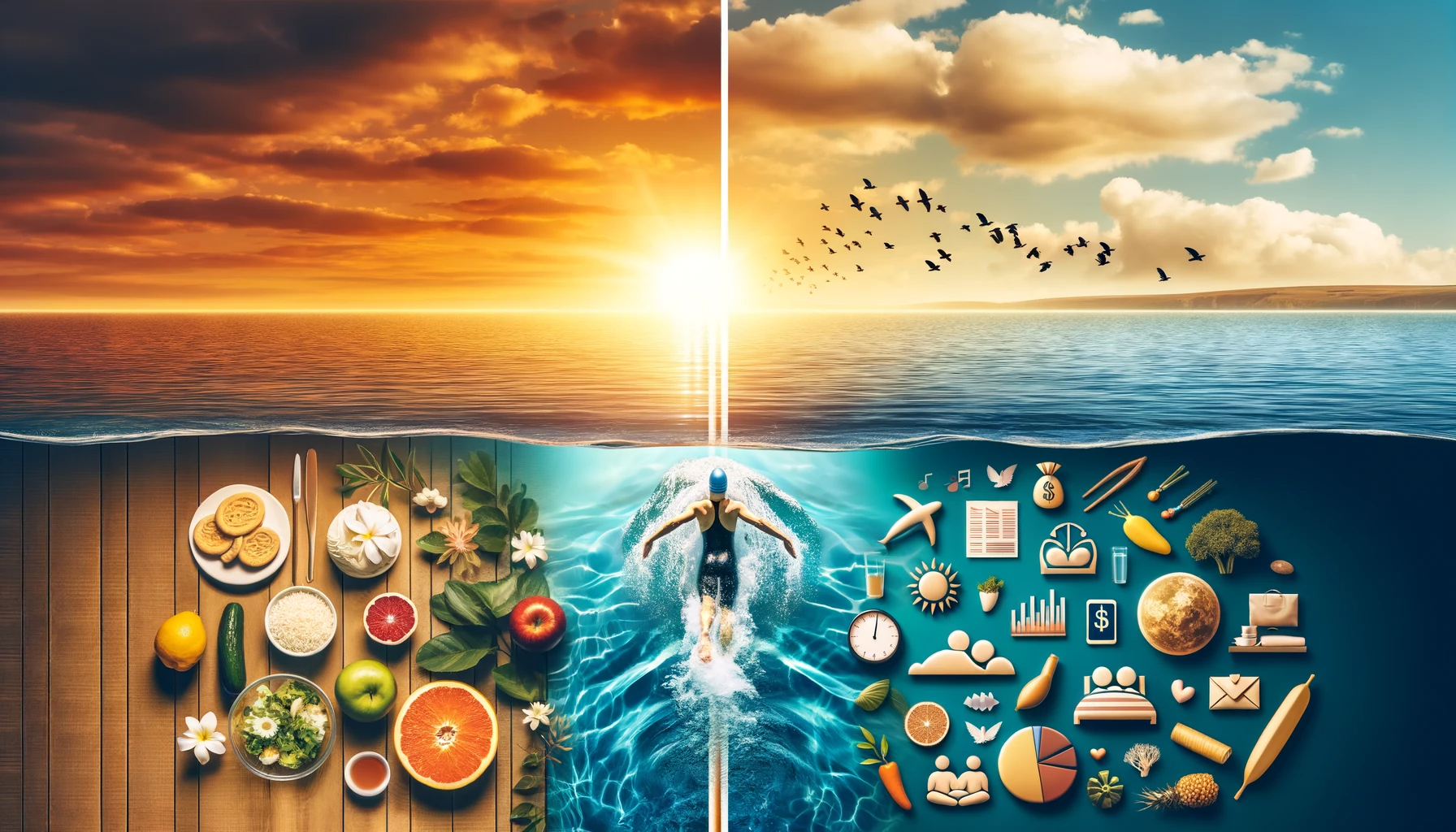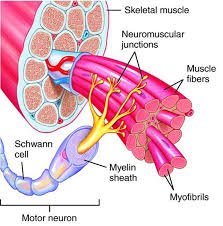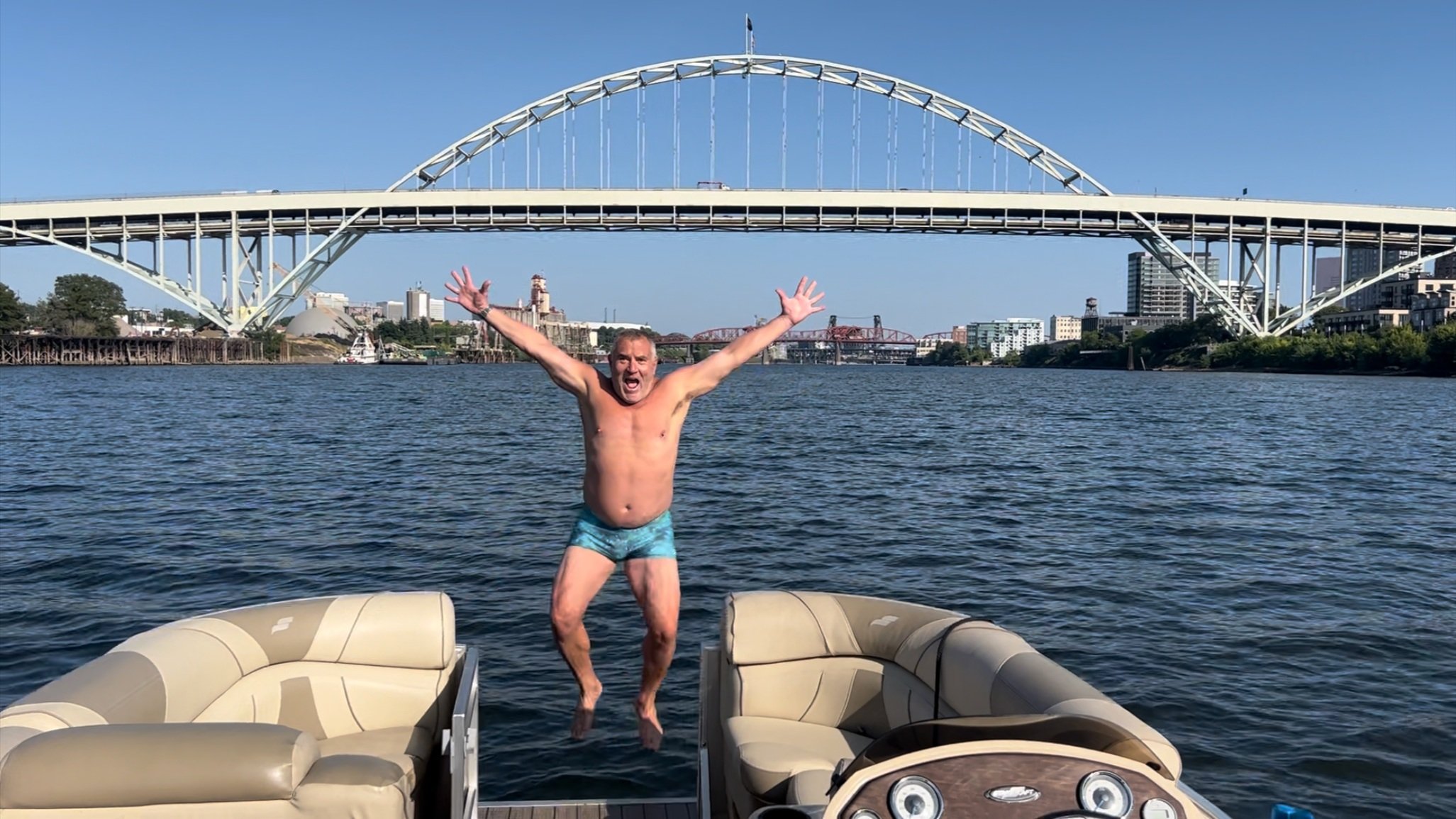
Welcome to My Lane
"Welcome to My Lane" is a refreshing splash in the face of conventional open water swimming. Crafted by a renegade swimmer nestled in remote Montana, this blog is for those who swim against the current. If you're tired of rules, regulations, and the self-appointed authorities of the sport, welcome to my lane.
Dive into unconventional wisdom with topics ranging from innovative training plans and nutrition to supplemental workouts and candid opinions on both open water and pool swimming. Expect a tone of uncharted waters that challenges the purist's version of the sport.
Join Coach Mark on a journey that's not just about swimming but thinking differently. Here, the real victory is in challenging norms and forging your own path. Dive in, swim your own swim, and make waves.
Navigating in Open Water: The Transition from Pool Precision to Open Water Freedom
Dive into the contrasting worlds of pool and open water swimming with our latest blog post! Discover how "Let's go get Mexican food" transforms from a tempting escape in the pool to an unheard whisper in the open water, where the initial cold shock bonds you to your commitment, leaving no room for escape until the training is done. Join us as we explore the mental and physical shifts that make open water swimming an unparalleled adventure.
Long distance swimming in a 25-yard, short course pool often feels like a test of willpower, with each length presenting a tempting opportunity to call it quits. "Let's go get Mexican food," becomes not just a casual suggestion but a siren call during our training sessions, tempting us to abandon our rigorous routine for the promise of immediate gratification.
Conversely, my passion for open water training sessions knows no bounds. Despite the initial shock of cold water, the moment I'm submerged, my commitment solidifies. In the vast openness, the absence of "walls" or endpoints strips away the temptation for early exits, leaving no room for thoughts of Mexican food until the training is rightfully done.
As the seasons change, so does the landscape of our swimming routines. Moving from the disciplined, stroke-focused sessions of winter pool training to the expansive freedom of open water swimming in the summer requires not just a physical adjustment but a mental and strategic one as well. For those of us who revel in the challenge of open water swimming, this transition, while eagerly anticipated, comes with its unique set of considerations. Let's dive into how to seamlessly shift gears, drawing from personal experience and a dedication to the sport that spans both the chlorinated confines of the pool and the boundless embrace of the open water.
Understanding the Transition
Training in the pool during the winter months offers the opportunity to refine technique across different strokes and focus on sprinting efficiency. This dedicated time allows for targeted improvements, utilizing a variety of equipment to enhance strength, technique, and endurance. However, as the ice thaws and the allure of open water beckons, the training focus shifts dramatically towards freestyle and mastering distances that stretch from 1500M to the daunting 30KM. This transition period, while exciting, requires a strategic approach to ensure a smooth adaptation to the changing conditions.
Bondi Pool and Beach in Australia where the pool meets the sea!
Preparing for the Shift
Gradual Transition: The key to a successful transition is not to rush it. Even as Flathead Lake warms up, maintaining a balance between pool and open water swims allows the body to gradually adapt to the differences in temperature, buoyancy, and pacing.
Visualize to Actualize: While still bound to the pool, use visualization techniques to prepare for open water races. Imagine navigating the vastness of Flathead Lake, focusing on your stroke rhythm and breathing pattern as if you were already there. This mental preparation bridges the gap between pool precision and the unpredictability of open water.
Embrace the Equipment-Free Approach: Transitioning to open water means leaving behind the comfort of fins, pull buoys, and paddles. This shift emphasizes the importance of raw technique and strength built over the winter months. Keep training sessions in the pool toy-free as the season progresses to mimic open water conditions.
Safety First: Although swimming alone in open water is not recommended, using a tow float for visibility is a wise precaution. For those who prefer solitude, ensure you're swimming in protected areas. When with a group, establish clear routes and regroup points to accommodate varying fitness levels.
Training Tactics for Open Water
Acclimatization: Continue cold water dips throughout the winter to ease the shock of lower temperatures. This practice not only prepares the body physically but also builds mental resilience against the initial discomfort of colder swims.
Group Dynamics: Navigating group swims in open water can be challenging. Communicate clearly about goals, distances, and expected pace to ensure everyone remains safe and can enjoy the session to their fullest.
Commitment Over Convenience: Open water swimming demands a level of commitment that pool swimming does not. Embrace this challenge as part of the allure. The decision to keep going, stroke after stroke, without the temptation of a pool edge, builds endurance and mental fortitude.
Looking Ahead
The anticipation for open water swimming fuels the winter months of disciplined pool training. The joy of finally diving into the vastness of a lake, with all the freedom and challenges it presents, is a reward for the months of preparation. Transitioning between these two worlds of swimming is not just about changing where we swim but also how we approach our training, our safety, and our mindset. As we look forward to the summer months, let's carry with us the precision honed in the pool and the adventurous spirit of open water swimming, ready to tackle whatever distances lie ahead with enthusiasm and preparedness.
Whether you're a seasoned open water swimmer or preparing to embark on your first open water adventure, remember that the journey from pool to lake is as much about embracing the process as it is about the final destination. Here's to smooth transitions, challenging swims, and the unbridled joy of open water exploration.
GEAR UP FOR OPEN WATER
The transition to open water swimming calls for a gear shift to match the unique challenges of the natural environment. Whether braving colder temperatures or navigating changing light conditions, the right equipment is crucial. Wetsuits and thermal swim gear become essential for comfort and endurance, while a variety of goggle styles and lens colors ensure clear vision through sun glare, overcast skies, or even under the moonlight. Post-swim, wrapping up in a warm parka, like a specially designed changing robe, can make all the difference in recovery.
At Flow Swimmers, we understand the importance of quality gear, which is why we've partnered with leading brands to outfit our swimmers from head to toe. From TheMagic5's custom swim goggles tailored to your exact fit, to DryRobe USA's open water parkas, Blue 70's superior wetsuits and thermal gear, and Swimoutlet.com's extensive range of swim essentials, we've got you covered for every open water challenge. Check out our GEAR page for our current progams and feel free to reach out to me with questions or to learn of our latest deals!
The Ultimate Swim Trip Packing Guide: What’s in Your Bag?
Embarking on a swim trip, whether it's for a competitive event or just an open-water adventure, requires meticulous preparation to ensure you have everything you need for both peak performance and comfort.
Embarking on a swim trip, whether it's for a competitive event or just an open-water adventure, requires meticulous preparation to ensure you have everything you need for both peak performance and comfort. From the essentials that support your swim to the gear that keeps you comfortable before and after the event, here's your comprehensive checklist and tips for packing smartly for your next swim trip.
I typically divide my travel pack into three categories:
Race Day
Non-Race Day
Travel
Essential Gear for Race Day
Tech Suit: My best tech suit for race day to ensure peak performance.
Goggles: Bring at least two pairs of goggles. Consider different tints for varying light conditions and ensure they are comfortable for long durations. Clear goggles are great for night swims!
Goggle Spray: To prevent fogging and maintain clear vision throughout your swim, goggle anti-fog spray is a must-have.
Bag Balm / Vaseline: To thwart chafing in those delicate places like armpits, between the thighs, and perhaps your shoulders and face.
Nutrition & Hydration: My personal feeding routine is Smucker’s Uncrustables (not available outside of North America), water with Mio (electrolyte solution), a few gels, and kids size yoghurt smoothies. It is recommended to feed as you train; don’t try anything new.
Support Gear: Water bottles, dog lead (for ease of bottle handling), cooler, mesh bags, Safe Swimmer Buoy, water-proof phone case, Garmin swim watch, and maps.
Lights or Glow Sticks: Attachable lights and glow sticks are necessary for night swims.
Other health related: Ibuprofen and sunscreen.
Optional Gear for the Non-Race Days
Training Equipment: Include items like a kickboard, pull buoy, and paddles if the trip involves training sessions or leisure swims on off days.
Additional Sun Protection: Sunscreen with high SPF, lip balm with sunblock, and a sun hat.
Towels: Bring a mix of towels, including microfiber towels which are lightweight, quick-drying, and ideal for travel.
Chargers: Remember chargers for all your devices (phone, computer, watch), including an international power converter if you are traveling abroad.
Clothing: Be prepared for all sorts of weather conditions…rain, wind, and cold. Consider bringing a DryRobe or changing parka for convenience. Also, think about shoes for hiking, fun, and the beach.
Travel Items
- Passport and Travel Documents: For international trips, double-check your passport validity and any necessary visas.
- Lanyard and ID: Keep your identification accessible, especially during official events.
- Cash and Credit Cards: Ensure you have the local currency and inform your bank of travel plans to avoid any issues with card usage.
- Chargers: Remember chargers for all your devices (phone, computer, watch), including an international power converter if you're traveling abroad.
- Entertainment: Bring a book, download your favorite podcasts or TV shows for the car or plane trip and for those boring hotel nights when you can’t get to sleep.
Packing Tips
1. Use a Checklist: Refer to this guide as you pack, checking off items to ensure nothing is forgotten. It is also good to have the checklist to remember to bring everything home (and not leave that charger plugged into the wall in the hotel!)
2. Pack Efficiently: Roll clothing to save space and use packing cubes to organize items by category (e.g., swim gear, nutrition, electronics). Use the mesh bags to compartmentalize.
3. Prepare for All Conditions: Weather can be unpredictable, so pack for various scenarios, including colder weather or rain…an umbrella, perhaps?
4. Click the image: Download a copy of the Travel Pack.
Conclusion
Preparation is key to enjoying a stress-free swim trip. By packing smartly and ensuring you have all the essentials, you'll be well-equipped to focus on what truly matters — the exhilarating experience of swimming in new waters. Remember, each trip is a learning opportunity, so take note of what items were most useful and adjust your packing list for next time. Dive in, swim strong, and enjoy every moment of your aquatic adventure!
WHAT’S IN YOUR BAG when you travel to open water events? Share your suggestions in the comment section below.
The Holistic Swimmer
I’ve been writing a bunch about training specificity, but now I’m going to contradict myself, as is my privilege, by summarizing everything with the HOLISITIC SWIMMER.
I’ve been writing a bunch about training specificity, but now I’m going to contradict myself, as is my privilege, by summarizing everything with the HOLISITIC SWIMMER.
First, lets take a moment to reflect on the journey we've embarked upon together, synthesizing the key concepts we've explored in the series "Mastering the Art of Specified Training in Swimming.”
1. Ultra-Short Race Pace Training (USRPT):
- We kicked off our series by diving into USRPT, emphasizing its versatility across different swimming distances and strokes. Remember, it’s not just for sprinters; it's a methodology that adapts to your specific race pace, whether that's a 50-meter dash or a marathon swim.
2. Muscle Fibers – Fast and Slow Twitch:
- Next, we explored the world of muscle fibers. Understanding the unique roles of fast-twitch and slow-twitch fibers is crucial in tailoring your training for either speed or endurance. Your body is a symphony of these fibers, each playing its part in your swimming performance.
3. Nutrition – Fueling for Success:
- Nutrition isn't just about what you eat; it's about finding a diet that resonates with your lifestyle, training needs, and personal preferences. We discussed debunking the 'bulk-up' myth and the importance of maintaining a balanced, consistent diet.
The Holistic Swimmer
The holistic swimmer is someone who recognizes that excellence in the pool is a reflection of harmony in various life aspects. It's about finding the right balance between rigorous training and personal well-being, between pushing your limits and nurturing your happiness.
In the holistic realm, we recognize that an athlete's performance is not solely dependent on what's on their plate. It's also about their feelings towards several key aspects of their life:
- Finances: Financial stress can directly impact dietary choices and mental well-being, both of which are crucial for training.
- Relationships: Harmonious personal relationships can provide emotional stability, enhancing focus and dedication to training and diet.
- Career and Job Satisfaction: A fulfilling professional life can boost overall happiness, positively influencing training and nutritional choices.
- Training Satisfaction: Enjoying and feeling good about one's training regimen can significantly affect dietary adherence and overall performance.
- Quality Sleep: Restorative sleep is crucial for recovery, and it's deeply interconnected with dietary habits.
- Diet: This is where nutrition directly comes into play, providing the energy and building blocks needed for training and recovery.
Many studies have shown how negative emotions impact athletic performance. Do not lose sight of your emotional baggage.
Your Unique Swimming Journey
As you move forward in your swimming journey, remember that the path to success is as unique as you are. Whether it’s adjusting your training methods with USRPT, understanding your muscle composition, fine-tuning your nutrition, or seeking harmony in your life outside the pool, each step you take is a part of a larger journey towards self-mastery in swimming.
Final Thoughts
Thank you for joining me on this enlightening journey through the art of specified training in swimming. As we close this series, I encourage you to carry these lessons with you as you carve your path in the waters of your choice. Keep swimming with purpose, passion, and a holistic perspective!
Nutrition in Long-Distance Swimming: The Balanced Approach
What's the real secret fuel for long-distance swimmers? In the latest entry of our 'Mastering the Art of Specified Training in Swimming' series, we're slicing through the waves of nutrition myths! 🍽️ From debunking the 'bulk-up' myth to why your favorite PB&J might just be your best pre-swim meal, we're diving deep into what fuels endurance in the water.
Thinking of 'bulking up' for your next cold-water swim because it will insulate you from the cold? Adding layers of fat for cold water is like packing for a polar expedition when you're just going to the fridge. Let's focus on acclimatization and leave the extra bulk for the bodybuilders!
The question of whether it's necessary to "bulk up" for cold water swims like the English Channel is a topic of ongoing discussion in the swimming community. Traditionally, many long-distance swimmers have believed that carrying extra body fat could provide an advantage in cold water by offering better insulation and buoyancy. However, this viewpoint isn't universally accepted, and there's a growing perspective that emphasizes overall fitness, adaptation to cold water, and individual physiology over simply adding extra body weight.
1. Cold Water Acclimatization: Adaptation to cold water through regular exposure is a crucial factor. Many swimmers train in cold water to acclimate their bodies, which can be as effective as carrying extra body fat. This acclimatization helps in regulating body temperature and improving the body's natural response to cold.
2. Body Composition vs. Fat Percentage: While extra body fat may offer insulation, it's not the only factor in cold water endurance. Muscle mass, metabolism, circulation, and individual physiological responses to cold also play significant roles. Some lean swimmers with good cold tolerance and efficient stroke techniques have successfully completed cold water swims.
3. Fitness and Endurance: High levels of fitness, strong swimming skills, and endurance are critical for challenging swims like the English Channel. Excessive body fat might actually impede swimming efficiency, increase drag in the water, and potentially affect stamina negatively.
4. Nutrition and Energy Efficiency: Efficient use of energy stores is vital in long swims. A well-balanced diet that optimizes energy use might be more beneficial than increased body fat. The focus is often on maintaining a diet that supports long-term endurance and energy availability.
5. Individual Variability: There's considerable individual variability in how swimmers respond to cold water. Some may perform well with a higher body fat percentage, while others may find that a leaner physique works better for them.
6. Scientific Evidence: There's a lack of extensive scientific research directly comparing the performance of swimmers with different body compositions in cold water endurance swims. Most evidence is anecdotal or based on personal experiences of swimmers and coaches.
Personally, I believe in maintaining one's ideal weight. It's about optimizing health and performance, not adding unnecessary pounds in the hope it'll keep you warmer. After all, efficient swimming and body heat generation come from well-trained muscles and a robust cardiovascular system, not just layers of fat. Assuming the additional weight will slow a person down, wouldn’t you rather swim a 12-hour English Channel rather than exposing yourself to the cold for a longer, 13-hour period?
Consistency in Diet: Stick to What You Know and What Works
As we gear up for big events, there's often a temptation to make drastic changes to our diet, hoping it'll boost performance. However, I advocate for consistency. Eating a healthy, balanced diet at all times is key. Changing your diet before a significant event can lead to unexpected results – and not always the good kind! Remember my PB&J post? Stick to what your body knows and loves.
Happiness: The Ultimate Nutritional Guide
As a coach, my primary goal is to ensure that my athletes are happy. This happiness transcends just being content with training regimes; it extends to their diet, body image, and overall lifestyle. Athletes who feel good about their diets, bodies, and training are more likely to perform better. It's not just about the calories or the nutritional content; it's about how these dietary choices fit into their overall sense of wellbeing.
Final Thoughts
In the end, the best diet for a long-distance swimmer is one that is sustainable, enjoyable, and health-promoting. Listen to your body, consult with experts, and maybe take a leaf out of Dr. Murch's book – experiment to find what works best for you. And always remember, your happiness and health are the true indicators of success.
Stay tuned for our next installment, where we'll dive into the world of mental preparation for long-distance swims. Until then, keep swimming and stay happy!
Muscle Fibers in Swimming: Optimized Performance
Ever wondered what makes a swimmer excel in a sprint but struggle in distance events, or vice versa? Dive into Part 2 of our series, 'Mastering the Art of Specified Training in Swimming,' where we unravel the mysteries of muscle fibers. We explore how the unique characteristics of fast-twitch and slow-twitch fibers shape a swimmer's performance and how targeted training can optimize these natural powerhouses for any event. Whether you're aiming for explosive power in sprints or enduring stamina in marathon swims, understanding and training your muscle fibers is the key to unlocking your full potential in the water.
Welcome back to "Mastering the Art of Specified Training in Swimming." After exploring USRPT in our first installment, we're now diving into the fascinating world of muscle fibers. How do they influence your swimming, and how can you train them for optimal performance?
The Myth: "Swimmers Are Either Sprinters or Distance Swimmers"
It's often said that sprinters are naturally endowed with more fast-twitch fibers, while distance swimmers have more slow-twitch fibers. While there's some truth here, it's not the whole story. Training plays a massive role in developing these fibers. Through specific training, you can enhance the efficiency of both fiber types, making you a versatile swimmer capable of excelling in various events.
Muscle fibers are not one-size-fits-all. They come in two primary types:
- Slow-Twitch (Type I): Think of these as your endurance experts. They're more efficient at using oxygen to generate fuel (ATP) for longer, sustained activities. They're crucial for long-distance swimming, helping you maintain pace without quick fatigue.
- Fast-Twitch (Type II): These are your sprinters. Type II fibers excel in quick, explosive actions but tire out faster. They're crucial in short, high-intensity bursts, like a 50m sprint.
Your training should reflect the demands of your events:
- For Sprinters: Focus on short, high-intensity sets. This approach targets your fast-twitch fibers, improving their ability to deliver explosive power when you need it most.
- For Distance Swimmers: Longer, steady-state swims are key. These sessions enhance the endurance capabilities of your slow-twitch fibers, allowing you to maintain a consistent pace over longer distances.
The Role of Specificity in Fiber Training
Remember the principle of 'specificity of motion' from our first post? It’s crucial here too. By training with the specific movements and pace of your race, you're directly targeting the muscle fibers most involved in those actions.
- Closer Look at Myelination
As we discussed previously, myelination is the process of developing a protective sheath around nerve cells, enhancing signal transmission. This process is vital for efficient movement. Consistent training in specific motions not only improves muscle fiber efficiency but also enhances myelination, leading to smoother, more coordinated movements in the water.
Practical Application in Your Training
Let's put this into perspective with an example. If you're training for a 200m freestyle event, your USRPT sessions might include sets like:
- 20 x 25m at your 200m race pace, focusing on maintaining form and speed throughout.
This set targets the muscle fibers and neural pathways involved in that specific event, enhancing both muscle and neurological efficiency.
Wrapping Up
Understanding and training your muscle fibers according to your swimming goals is key to success. Whether you lean towards sprints or endurance, a tailored approach to muscle fiber development can elevate your performance significantly.
Next up in our series, we'll tackle the crucial topic of nutrition in swimming. Stay tuned!
